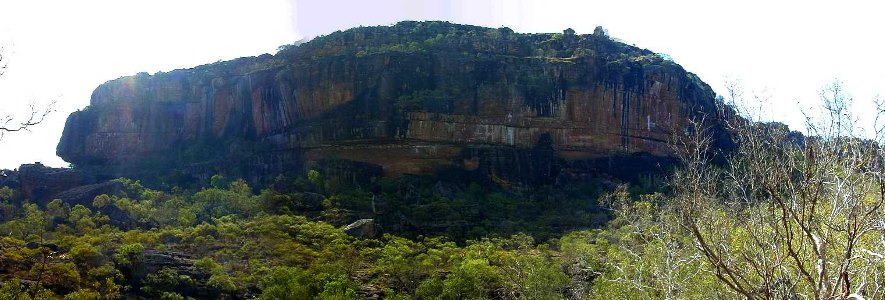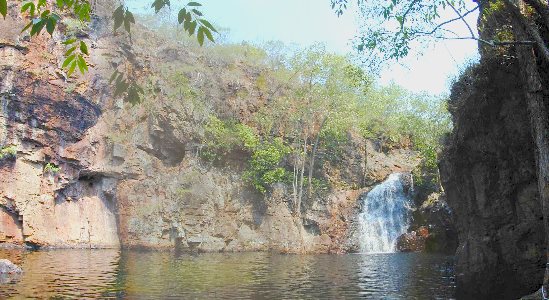With a trail down to a very rocky beach.
We saw kangaroos along the road not far outside of town.
We were headed for Kakadu National Park.
First stop, a museum of Aboriginal art, crafts, and tools.
Their calendar is based on the weather that is dominant at that time of year.
Gudjewg is the monsoon season. Bang Gerreng is knock em down storm season.
Continuing around are the cooler but still humid season, cold weather season, hot dry weather season and pre monsoon season.
Message sticks, a fish trap, and a leaf basket filled with marrgardba bee honey.
There was a display of string figures but I couldn't find anyone who could show me how to do them.
Next stop Ngurrungurrudjba (it is pronounced just the way it looks).
Europeans called it the Alligator river. No alligators only crocodiles though.
We took a tour on a pontoon boat.
To see lots of wildlife.
Ducks
A couple of kinds of Cormorants
A crane, three ibises, a pelican and two kinds of ducks.
An eagle's nest and then the eagle.
Another crane, Magpie Geese and a Purple Swamphen.
This guy is called a Jesus Bird because he is able to walk on water, actually he has big feet and stays on the lily pads.
The Azure Kingfisher has a remarkably long beak.
I haven't identified the other kingfisher but he is one of the 5 kinds they have in the park.
A Crowned Crane and another unidentified bird.
We didn't just see birds. Nancy spotted this crocodile and pointed it out to our guide.
From there we went to Burnggui and Anbangbang

Aboriginal rock art.
The big guy in the middle is Namarndcig who broke the incest laws.
The skinny figure on the right is Namarrgon, the lightning man, and the one on the lower left is his wife.
Figures dancing in the first picture and a hunt.
Huge termite mounds. On close examination we found that some had been taken over by ants.
We saw many places where fires were burning.
This is considered a natural part of the environment so nothing is done to control them if they aren't directly impacting structures.
The haze that was produced made for interesting sunsets.
We then set off down the Stuart Highway to see some of the waterfalls and swim in the pools of Litchfield National Park.
On the way we stopped at Howard Springs where we saw this very friendly ibis looking for a handout.
The butterflies were a bonus.
Further on we saw some magnetic termite mounds, so called because their very narrow slabs are all oriented in a north-south direction.
This panorama shows the mounds north of us on the left and to our east on the right.
The area had recently been burned over, some areas were still smoldering.

A single slab viewed from the west.
It had been quite hot (49C that's 120F) so we were looking forward to a swim at Wangi falls.
That is until we saw the warning sign.
Apparently the ability to recognize the difference between the fresh water and estuarine crocodiles is useful.
Then you will know whether they are likely to kill or just injure you.
Lots of people were swimming, most of them looked more tender than we did so we decided to go in.
Painting in the Aboriginal style using modern materials.
A swim at the base of Florence falls.
No crocodile warning there.

Other falls along the way.